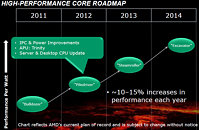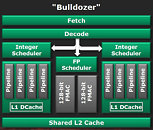Thursday, October 13th 2011

Bulldozer Aims For 50% Improvement By 2014: Is This Really Enough To Counter Intel?
The reviews are now out for AMD's brand new Bulldozer architecture, in the form of the Zambezi FX 8120 & FX 8150 processors and they don't paint a pretty picture of these flagship products. The chips use lots of power, run hot and significantly underperform compared to their Intel competition. On top of that, they are being marketed as 8 core processors, when they are actually 4 core with an advanced form of multi-threading, due to the siamesed nature of each dual processor module. Perhaps to counter this negative publicity and try to restore some faith in the AMD brand, they have released a roadmap for the planned improvements to the architecture, all the way to 2014 - an ambitious timeline, given how much and how unexpectedly things can change at the cutting edge of the technology world.Looking at the chart, one can see that the various architectures Piledriver, Steamroller and Excavator all add up to between 30-50% projected improvement by 2014 (subject to change without notice, of course). These are all names designed to impart a tough-guy image to their products to give one the impression that they must perform very well, beating the competition into submission. Therefore, if they fail to perform competitively against Intel, those names will continue to be branding embarrassments like Bulldozer is, currently. As Intel is already 20-50% faster right now depending on the benchmark, how are these modest improvements possibly going to compete with Intel's future products? AMD has already had a change of management at the top recently, so we can only hope that the right CEO comes along and turns them around, otherwise they may end up not manufacturing x86 processors at all in future, possibly becoming a GPU company only.
The main problem with the current Bulldozer architecture is that it's very, very late to market. AMD started working on it four years ago in 2007, which is a very long time in the world of desktop processors, so AMD have effectively released a new "old" product. The two important things that it has going for it, are that it scales well with core count and clock speed - those 8GHz overclock marketing demos weren't completely without merit. What we need to see is AMD improving performance much more than the prediction slide they've released, more like 100% or more perhaps, which is not really such an unrealistic target to achieve in three years of design and process improvements. Perhaps discarding this whole architecture and starting afresh with fully discreet cores like on the Phenom might be the way forward? AMD has recently let go some of its top-level management, so perhaps their replacements can turn the company around?
So, even if AMD achieves this projected performance improvement and more, will it really be enough to counter Intel, or will Intel steamroller AMD's Bulldozer back into submission?Source:X-bit labs and Bulldozer block diagram courtesy of Hexus' FX 8150 review.
The main problem with the current Bulldozer architecture is that it's very, very late to market. AMD started working on it four years ago in 2007, which is a very long time in the world of desktop processors, so AMD have effectively released a new "old" product. The two important things that it has going for it, are that it scales well with core count and clock speed - those 8GHz overclock marketing demos weren't completely without merit. What we need to see is AMD improving performance much more than the prediction slide they've released, more like 100% or more perhaps, which is not really such an unrealistic target to achieve in three years of design and process improvements. Perhaps discarding this whole architecture and starting afresh with fully discreet cores like on the Phenom might be the way forward? AMD has recently let go some of its top-level management, so perhaps their replacements can turn the company around?
So, even if AMD achieves this projected performance improvement and more, will it really be enough to counter Intel, or will Intel steamroller AMD's Bulldozer back into submission?Source:X-bit labs and Bulldozer block diagram courtesy of Hexus' FX 8150 review.


132 Comments on Bulldozer Aims For 50% Improvement By 2014: Is This Really Enough To Counter Intel?
I am an enthusiast with low income, I bought my 5770 a year after its launch. And now with HD7000 at the horizon, I worked my butt off to get me a new rig. But alas the HMS AMD hit an iceberg, does the hull made of scrap? is there a breach in the hull? is there an intelligent being left onboard?
My ATHLON 64 X2 5200+ has been with me for 3 good long years, and now I am thinking of buying ether a VGA card or SSD. To have a HD6850 or above and then much later when I see a processor worth buying I'll add another HD7000 and called the machine "Zeroshift : Generations". I just hope its an AMD, but if it's an INTEL? then I call it "Zeroshift : Lost Generation".
Just a Vent, sorry about taking space :banghead:
At least they've got Ati to fall back to... What a shame, as others said, we can only wait and watch as Intel processor prices go sky high, so much promise wasted...:shadedshu
I guess AMD learned nothing from ATi's mistakes. When ATi released released chips with architectures that were too forward thinking performance suffered. We don't need chips that will supposedly handle highly threaded applications very well five years from now. We need chips that run today's moderately threaded applications well.
Now if they would have said a 30% faster on windows 8 new threading capabilities then it would be worth putting out there.
VGA upgrade? going from 9600GT to GTX 460SE oc'd for me didn't offer much difference, changing the processor however, is a different story.
That's what everyone said about bulldozer .. .. :shadedshu
I don't expect SB IPC at all, but getting WORSE single-threaded IPC over the ancient K10.5???? I have no faith in what they'll do in the next few years.
Honestly, they shouldn't have even released BD for desktop CPUs. They should have done an entire K10.6 update as they did on Llano and then work hard on a BD fix for the major issues it has.
In your case it seems an issue with memory bandwidth, which PII lacks (Sandy Bridge has almost twice). The FX falls right in the middle in that regard.With the fact that Piledriver is being released so soon I believe that AMD knew about the design's problems (branch prediction, pipeline flushing, cache trashing, decode unit not wide enough) but instead counted on higher frequencies to make up until Piledriver could be released. Anandtech's review also shows that cache latency is worse than Phenom II. Both problems can be blamed on Global Foundries' poor 32nm process. Cache latency can be increased and clockspeeds lowered to get higher yields.
I think that AMD saw the problems that needed reworking but decided that clockspeed would be enough to counter them for the time being but then a few months later they find that yields were too poor and had no choice but to launch as is.
Ive always had AMDs since Duron but im really considering going Sandybridge because i dont think AMD have anything going for them anymore.
so that would be 2020 + in the real world?
AMD needs fix there mistakes in 3 months and actually release it on time.
Other wise they will lose more and more people.
Therefore AMD is aiming at 50%/225% of the performance envelope, which is only 20% of what Moore's law would predict as being theoretically possible.
Now, is Moore's law completely wrong, or is AMD complete FAIL?
++++++
Someone made a very valid observation in a previous post, that AMD made a strategic mistake by killing the CPU design team and replacing them with a cpu-by-software construction kit playgroup. It's like replacing machine code/assembly programmers with people who can only write stuff in BASIC. No matter how good the compiler, a compiled BASIC program will never get anywhere near the performance of hand coded machine code. And it will also miss many conceptual tricks for performance along the way.
AMD is so far behind they have to admit they are now in a different race. They need to target the value segment and third world segments. I think they could do well developing PC SoC concepts... everything but the RAM on one chip. Great, cheap, small middle- and low-end stuff. Perhaps they should also try their hand at consoles. :roll:
BD is more power hungry than SB AND performs worse. But i don't disagree, BD (in PD guise) has more potential but then Ivybridge should release on a smaller fab with better power efficiency than SB and better performance.
AMD will lag behind whichever way you look at it. It needs to stop shouting about how great it is and deliver a cost/performance winning chip - which BD isn't compared to it's own Phenom 1100.
haha, Im only kiddingYes!!! It will be an INCREDIBLE year for intel. AMD will be pushed to the back of the queue again mulling over dated fabs & silicon while Intel will already be 2 or 3 generations ahead.
It wasnt too long ago where AMD just released a good enough CPU to run toe to toe with a Core 2 Quad, Unfortunately the Core 2 era has long since been in the process of being phased out.
I have no idea if piledriver will be any good but Intel sure has a lot of work to do and they wont stop
And in 2014 when AMD can finally drop the sad puppy dog eyes "I-made-a-good-CPU-I-did-I-really-did!" look for their BD CPUs, they will be already obselete and nobody will care.
and since their design is already in the open. who says that intel wont try to create an architecture that uses the same or similar feature or something thats BETTER then it.
ask yourself....who are you fooling but yourself?
Trololol